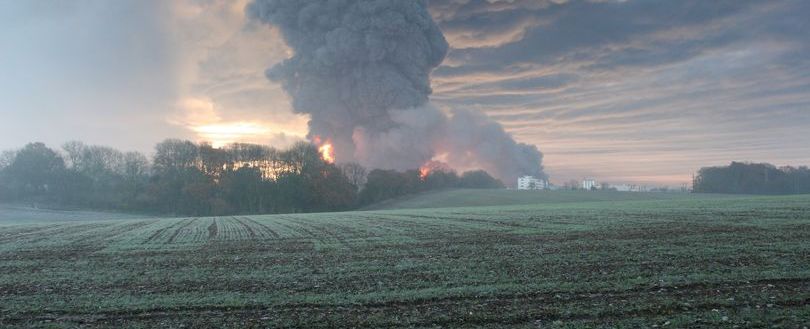- Homepage
- News
- Blogs & Articles
- On This Day, Historic Disaster: Buncefield Fire

On This Day, Historic Disaster: Buncefield Fire
Like it? Share it!
In the early hours of Sunday, 11th December 2005, the Buncefield oil storage facility, located in Hertfordshire, UK experienced a fire. The terminal, owned by Total UK Limited (60%) and Texaco (40%), housed the fifth-largest oil-products storage depot in the UK, with a capacity of approximately 60 million Imperial gallons of fuel.
The initial explosion triggered a series of blasts that overwhelmed 20 large storage tanks, leading to a major emergency declaration by the emergency services at 06:08. The cause was identified as a fuel-air explosion in a vapour cloud of leaked petrol. The event, monitored by the British Geological Survey, registered 2.4 on the Richter scale.
The final report from the Major Incident Investigation Board (MIIB), published in February 2011, sheds light on critical factors leading to the incident. The investigation revealed that Tank 912 was being filled with petrol, employing a manual level gauge and an independent high-level switch as safety measures.
However, a malfunctioning manual gauge and an inoperative shut-off switch meant that Tank 912 was being filled without a clear level indication. The tank eventually reached full capacity, causing petrol to overflow, form a ground-level vapour cloud, and subsequently ignite, resulting in a five-day fire.
The inquiry uncovered that the level gauge had randomly malfunctioned following a tank service in August 2005, with no alarm raised by maintenance contractors or site management. Additionally, the independent shut-off switch lacked a critical padlock, rendering it ineffective. Failures in secondary containment, designed to confine petrol within a retaining wall, allowed fuel to escape. Tertiary containment, intended to prevent chemical spills from reaching the environment, also failed, leading to the contamination of groundwater with fuel and firefighting foam. The investigation identified inadequacies in the design and maintenance of both secondary and tertiary containment systems.
Management shortcomings were identified as contributing factors to the explosion. Safety checks at the site were found deficient, and protocols were not consistently followed. Site staff lacked control over the flow rates and timing of two of the three inlet sources, resulting in inadequate information for proper fuel storage management. Further, an increase in overall throughput exacerbated wait times and shifted the focus from process safety to process operations, further accentuating the management failings that played a role in the tragic incident.
Emergency responders, with peak efforts involving 25 fire engines, 20 support vehicles, and 180 firefighters, faced a daunting task. The explosions, noticeable up to 125 miles away, caused widespread damage, including broken windows, blown-in doors, and structural issues in surrounding buildings. The incident resulted in 43 reported injuries, with two individuals seriously harmed.
The firefighting operation, one of the largest in the world, involved 150 firefighters working tirelessly to contain the fire. Challenges arose, including delays in using foam due to pollution concerns. Despite initial progress, ruptures and re-ignitions prolonged the incident, impacting nearby communities. Evacuations were enforced, and over 2000 people sought alternative accommodation.
The aftermath saw 244 people requiring medical assistance, while concerns for public safety led to the closure of schools, libraries, and public buildings across Hertfordshire and Buckinghamshire. Evacuations and health advisories were issued, affecting thousands of residents.
Legal actions ensued, with a High Court finding Total UK liable for the explosion, facing potential damages of £700 million. Criminal prosecutions under the COMAH regulations saw fines imposed on Total UK, Hertfordshire Oil Storage Ltd, and others, though some deemed them as modest.
Reflecting on the Buncefield fire serves as a poignant reminder of the critical importance of robust safety measures. Lessons learned from this incident continue to shape regulations and practices, ensuring the safety of facilities and communities.
View the source.
-
FIA Team
FIA Team
Related posts
Related news
-
Fire Officers Share Tips for Safer Caravan Holidays
17 April 2025
-
Government Extends Waking Watch Replacement Fund
15 April 2025
